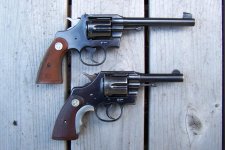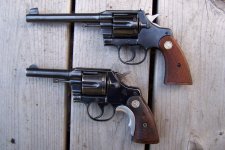You are using an out of date browser. It may not display this or other websites correctly.
You should upgrade or use an alternative browser.
You should upgrade or use an alternative browser.
Bought My First Colt
- Thread starter Kingspoke
- Start date
DWalt
Member
It's often said that a really top-ranked competitive shooter could shoot a few points higher with a Colt than a S&W. And many old-time Bullseye shooters preferred Colt revolvers. I have both an OMT and an OMM in .38 Special. I see no detectable difference between their performances, although I like the OMT a wee bit better.
Those Bullseye competitive shooters remaining today do not use revolvers. Or at least very, very few do.
Those Bullseye competitive shooters remaining today do not use revolvers. Or at least very, very few do.
Last edited:
I think the Officers Model is more akin to the K frame Target models than the Outdoorsman. The New Service Target would be more of a match frame-wise to the Outdoorsman. And shame on you for getting a Colt, who would do such a thing.... oh wait, I would. (Click on the pics for a larger version.)
As I said, more like the K frame Targets than the Outdoorsman....
If we're talking frames, I totally agree with that! You have some real beauties there, which also illustrate your point.
Overall my understanding is that the Colt OMT and the S&W were the top target models of the pre war era. You had the "McGivern like" camp and the preponderance of other target shooters preferring the Colt.
Did I get this comparison wrong? I don't know, but I have two beautiful target models from 1937. Both great representatives of American ingenuity.
It's often said that a really top-ranked competitive shooter could shoot a few points higher with a Colt than a S&W. And many old-time Bullseye shooters preferred Colt revolvers. I have both an OMT and an OMM in .38 Special. I see no detectable difference between their performances, although I like the OMT a wee bit better.
Those Bullseye competitive shooters remaining today do not use revolvers. Or at least very, very few do.
You've captured my rudimentary understanding of how competitive shooting in that era developed. It's great to own a gun like the OMT, knowing it was the best that Colt had to offer for .38 target shooting.
Tom K, I'm just getting my feet wet on this so, I'm reading more about the NST to catch up with your comments. These damn Colts!
DWalt
Member
One reason that Colt revolver accuracy performance is considered by some to better than S&W is that the Colt cylinder is held more firmly in place when the hammer falls. That is part of the Colt's design.
One reason that Colt revolver accuracy performance is considered by some to better than S&W is that the Colt cylinder is held more firmly in place when the hammer falls. That is part of the Colt's design.
Yes, the lockup on a Colt is tight. But if you slowly pull the trigger in DA, you will see the Smith lock up before the hammer falls, and the Colt while on the way down. Timing is much more critical on the (pre-Mk lll) Colt. While going through the Police Academy, I was told by the range officer that 90% of the (personally owned) guns on the line were Smiths and 90% of the malfunctions Colts.
Bob
27 Man
Member
Looks like you found a nice one. I have have a 30s era Officers Model with the heavy barrel and a lanyard ring. I took it and my 70s era K-38 out for some comparison shooting and found little discernible difference. The advice I was given when I got mine was that the Colt can easily develop timing issues and there aren’t many Colt mechanics around anymore. Be careful with it.
mike campbell
Member
- Joined
- Dec 27, 2014
- Messages
- 542
- Reaction score
- 1,560
When you do your "side by side comparison", I would caution you not to expect your favorite S&W's favorite load to perform the same in your Colt.....it could be abysmal and give you the impression the Colt is inferior.
It's not uncommon for an accurate load in one gun to be not so accurate in another of the exact same model. Without saying which is "better", there are many significant differences between the S&W and Colt...bore and groove diameters, rate of twist, cone configuration, etc.
As an aside, I have a 6" OMM and 4" Model 15. When testing 7 different loads in the two revolvers I found, in every single instance, velocities were higher from the 4" Smith than the 6" Colt .... as much as 100 fps faster. I don't think anyone could have predicted that. So, is that good or bad? I'd say neither, just different and surprising.
It's not uncommon for an accurate load in one gun to be not so accurate in another of the exact same model. Without saying which is "better", there are many significant differences between the S&W and Colt...bore and groove diameters, rate of twist, cone configuration, etc.
As an aside, I have a 6" OMM and 4" Model 15. When testing 7 different loads in the two revolvers I found, in every single instance, velocities were higher from the 4" Smith than the 6" Colt .... as much as 100 fps faster. I don't think anyone could have predicted that. So, is that good or bad? I'd say neither, just different and surprising.
... the Colt can easily develop timing issues and there aren’t many Colt mechanics around anymore. Be careful with it.
That is simply not true, and I would like that internet legend would go away.
Here are two Colts of mine...
Attachments
S&W did not have a frame size similar to the Colt E/I frame until S&W came out with the L frame in the 80's.
DWalt
Member
When you do your "side by side comparison", I would caution you not to expect your favorite S&W's favorite load to perform the same in your Colt.....it could be abysmal and give you the impression the Colt is inferior.
It's not uncommon for an accurate load in one gun to be not so accurate in another of the exact same model. Without saying which is "better", there are many significant differences between the S&W and Colt...bore and groove diameters, rate of twist, cone configuration, etc.
As an aside, I have a 6" OMM and 4" Model 15. When testing 7 different loads in the two revolvers I found, in every single instance, velocities were higher from the 4" Smith than the 6" Colt .... as much as 100 fps faster. I don't think anyone could have predicted that. So, is that good or bad? I'd say neither, just different and surprising.
There have been similar discussions here before. When it comes to muzzle velocities in a revolver, even those having the same barrel length, every one is a law unto its own. And that's not just comparing a Colt to a S&W. Citing the foregoing, I can state the reverse. Some time ago I was comparing .38 Special wadcutter MVs fired from a Colt .357 with a 6" barrel against a S&W Model 14, same barrel length. With the exact same loads, the average MV from the Colt was about 80 ft/sec greater than from the S&W. Why? I don't know, but most probably slight dimensional differences, especially in the cylinder-barrel gap. One of the Speer reloading manuals discusses this same phenomena in some detail. Moral - don't believe MVs given in any reloading data sources regarding revolvers.
^^^ I have two S&W Model 28 revolvers, a 4" and a 6". The muzzle velocities are nearly identical. They were made within a few years of each other.


 Hmmmmmm...
Hmmmmmm...
S&W did not have a frame size similar to the Colt E/I frame until S&W came out with the L frame in the 80's.
Interesting, and good to know that. Thanks!
I still have my first Cobra, purchased new in 1968 for $85, as an off duty gun.
Very nice! Obviously that lil Colt was not only practical but something that endeared itself to you.
One reason that Colt revolver accuracy performance is considered by some to better than S&W is that the Colt cylinder is held more firmly in place when the hammer falls. That is part of the Colt's design.
This is echoed by my FFL who is a big Colt collector, as many here are also.
That is simply not true, and I would like that internet legend would go away.
Here are two Colts of mine...
There is just something classy about the bottom one, which I would guess is a Police Positive(?), but it has that 38/44 HD (underlug aside) working gun charm, to it.
Thanks for sharing those two beauties!
Last edited:
That is a Colt Army Special, inherited from my dad. It was made in 1927 (the same year as him!). It is built on the same frame size as the Officer's Model and later Python. These were all basically the same guns except for sights, and the Python's frame mounted firing pin and the dude finish on the Python.
The one above it is an Officer's Model, which was also made in 1927. Both revolvers are in .38 Special.
The one above it is an Officer's Model, which was also made in 1927. Both revolvers are in .38 Special.
Last edited:
DWalt
Member
The Colt Army Special is, except for a few minor cosmetic changes, identical to the later Colt Official Police. Colt merely changed the name in 1927 for marketing purposes. It was easier to sell a revolver named the "Official Police" to police departments. Colt made a lot of hay in the 1930s by advertising that the OP was capable of firing the more powerful .38-44 round used by the S&W N-frame HD. In fact, most any .38 Special revolver could fire the .38-44 round safely also, but Colt didn't mention that.
The Colt E-frame is slightly larger than the S&W K-frame because Colt's frame design was to accommodate the larger diameter .41 Long Colt round, whereas the S&W K-frame was designed around the smaller diameter .38 Special. All things exist for some reason.
The Colt E-frame is slightly larger than the S&W K-frame because Colt's frame design was to accommodate the larger diameter .41 Long Colt round, whereas the S&W K-frame was designed around the smaller diameter .38 Special. All things exist for some reason.
Last edited:
The Colt Army Special is, except for a few minor cosmetic changes, identical to the later Colt Official Police. Colt merely changed the name in 1927 for marketing purposes. It was easier to sell a revolver named the "Official Police" to police departments. Colt made a lot of hay in the 1930s by advertising that the OP was capable of firing the more powerful .38-44 round used by the S&W N-frame HD. In fact, most any .38 Special revolver could fire the .38-44 round safely also, but Colt didn't mention that.
The Colt E-frame is slightly larger than the S&W K-frame because Colt's frame design was to accommodate the larger diameter .41 Long Colt round, whereas the S&W K-frame was designed around the smaller diameter .38 Special. All things exist for some reason.
Awesome information! You've distilled a volume of information that would have taken me some time to realize. Another reason I love this site.
Very interesting Colt history (including 41 LC), & also somewhat explains my mis-identification.
Similar threads
- Replies
- 2
- Views
- 149
- Replies
- 7
- Views
- 602
- Replies
- 39
- Views
- 2K
- Replies
- 94
- Views
- 4K


